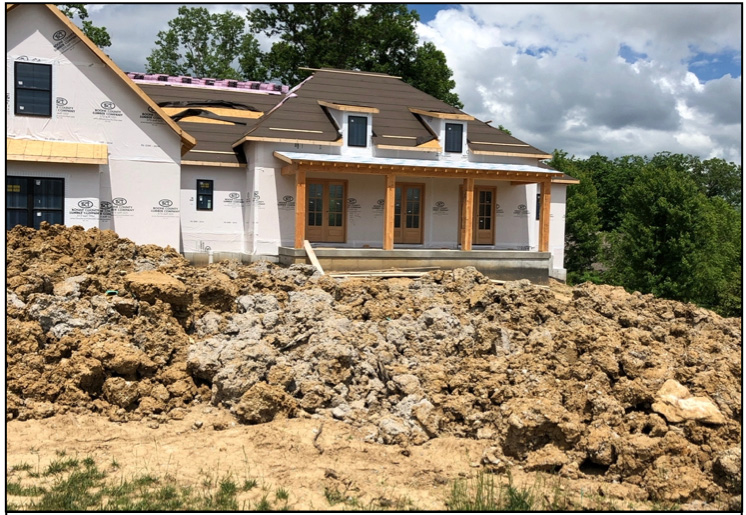Recently, home lawns have been maligned in several media outlets as a waste of time and resources. Mismanagement by using too much water or misplacing fertilizer may compound the issue by straining environmental resources or serving as pollutants. While not going into all the defenses for turfgrass use on home lawns, (remember “right plant, right place”), one of the major benefits lies a little further beneath your feet… the soil.

A nice start to a house for people, but not so suitable for plants. Photo credit – Dr. Bill Wiebold
With its dense cover and extensive fibrous root system, turfgrass is undoubtedly one of the best defenses against soil erosion. Much publicity goes to human-applied pesticides and fertilizers as major contributors to environmental pollution, but often overlooked is the actual movement of soil. When soil moves, all of its properties – including pollutants, move along with it. Combined with its low growth habit, reduced cover for pests like rodents, ticks and mosquitoes, and lower heat retention compared to concrete, grass is the logical choice as a base plant species for open areas like roadsides and lawns to prevent soil erosion.
As a turfgrass pathologist, my position is partly to serve as a coroner. Working with the Purdue Plant and Pest Diagnostic Lab, we investigate various cases of decline of turfgrass from golf courses, sports fields and home lawns. Surprising to some, the primary cause in most of these instances is not a turfgrass disease, but is instead an abiotic disorder such as lack of fertility, mowing during drought, traffic, compaction, salt, etc. Many of these issues tie back to the soil – the foundation of the plant itself.
Nitrogen (N), is the most limiting nutrient for turfgrass, and in many cases home lawn submissions are deficient. Nitrogen is dynamic in the soil and constantly removed by mowing, so unfortunately can’t be guided effectively by soil tests. Instead, on older lawns consider applying 1.5 – 2 lb N/1000 sq ft a year to match growth and N removal by mowing. Critics may balk that this fertilizer amount is excessive, but required N amounts for corn and soybean are often 200-250 lb N/A depending on yield goal, which equates to approximately 4.5 – 5.7 lb N/1000 sq ft. A bit more N (0.5 – 1 lb) may be needed the first few years on younger seeded lawns to make up for the lack of microbial activity and nitrogen cycling. If the lawn is sodded, this may be overcome by the residual nitrogen applied at the sod farm and microbial activity brought in with the adhering topsoil.
In new home construction, much of the topsoil is removed, and if the homeowner is fortunate a portion of it may be returned. Life was lived in this topsoil, meaning organic matter, nutrient cycling and the microbial community primed it for the success of plant growth. These characters are devoid in a subsoil, which is often gray or light colored, clayey, resists water infiltration, has severe nutrient deficiencies and is susceptible to compaction. That turfgrass often overcomes these deficiencies in any capacity is a testament to its resiliency, (also witnessed recently in regard to drought tolerance). The plant itself becomes the driver of organic matter accumulation and topsoil regeneration.
Soil testing is a step often neglected by homeowners regarding lawn care. A soil test can guide application of phosphorous, potassium, calcium and other macro and micronutrients, as well as give important information regarding soil pH, CEC and organic matter amount. A soil test may indicate that a subsoil type still persists in the lawn, and light applications (e.g. topdressing) of organic matter or topsoil may aid in rebuilding the soil and turfgrass density.
If your lawn continually struggles, consider getting a soil test (see below) to determine if a major nutrient deficiency or chemical/physical parameter is an underlying cause.
A list of soil testing laboratories can be found at https://ag.purdue.edu/department/btny/ppdl/_media/publications/miscellaneous/4-soil-testing-labs.pdf.